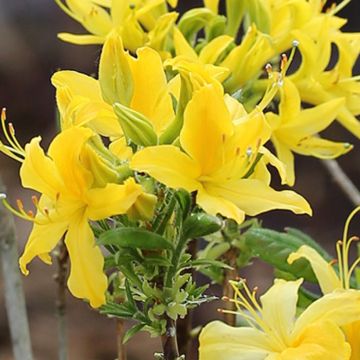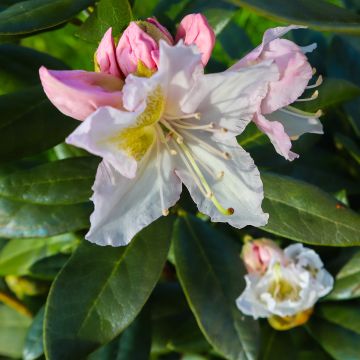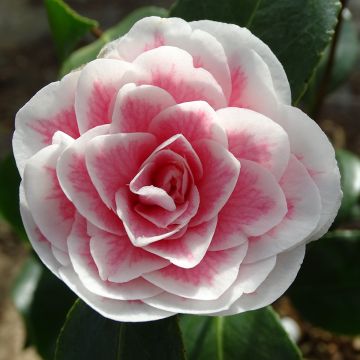

Rhododendron tsariense


Rhododendron tsariense
Rhododendron tsariense
Rhododendron tsariense
Rhododendron
Lovely little bush arrived in good condition...
Nathalie, 24/08/2024
This item cannot be shipped to the selected country
Delivery charge from €5.90
More information
Schedule delivery date,
and select date in basket
This plant carries a 24 months recovery warranty
More information
We guarantee the quality of our plants for a full growing cycle, and will replace at our expense any plant that fails to recover under normal climatic and planting conditions.
From €5.90 for pickup delivery and €6.90 for home delivery
Express home delivery from €8.90.
Does this plant fit my garden?
Set up your Plantfit profile →
Description
Rhododendron tsariense is a modest Himalayan botanical species with particularly attractive foliage due to the visible tawny to russet felting underneath the leaves. Its spring flowering, delicately coloured in white with a touch of pink, is charming. The bush is attractive in all seasons. No more difficult to grow than hybrid rhododendrons, it will delight owners of small gardens, as well as collectors!
Rhododendrons are plants from the heath family, just like heathers. These plants prefer soils devoid of limestone, with an acidic tendency, well-drained soils, and humid climates. Rhododendron tsariense is native to Bhutan, south and southeast Tibet, and Assam, where it grows between 3,000 and 4,000 metres (10 and 13 feet) above sea level. It was introduced to Europe in 1914. It is a frost-resistant plant.
This small shrub has a bushy, fairly branched, rounded habit, reaching a height and width of about 1.30 metres (4 feet), under good conditions. The woolly branches, covered in hairs, bear leaves that are obovate to oblong in shape, measuring 2 to 7cm (1 to 3in) long, with a persistent white pubescence on the upper side throughout the growing season and beyond. The underside of the leaves presents a woolly covering, initially whitish, turning tawny and then russet at maturity. The young shoots and flower buds are also woolly. Flowering usually occurs in April, earlier or later depending on the climate. The bell-shaped flowers, measuring 2.5 to 3.5cm (0.79 to 1.18in) long, are grouped in threes to six. They are white to pale pink or white-washed with pink and speckled with crimson. This flowering is not fragrant. This bush likes partial shade and moist, humus-rich, well-drained soil with an acidic pH ranging from 4.5 to 6.5.
Rhododendron tsariense enchants with the beauty of its foliage and pastel flowering, which precedes that of most other "Rhodos." It can be used in isolation, in a damp rockery or in a mass planting, always in partial shade and of course in the company of other acid-loving shrubs, in well-drained soil. It can be associated with Japanese azaleas, small deciduous magnolias, andromedas (Pieris), painted ferns, and more. Its small size also allows it to be grown in a large pot on a slightly shaded terrace.
Report an error about the product description
Rhododendron tsariense in pictures




Plant habit
Flowering
Foliage
Botanical data
Rhododendron
tsariense
Ericaceae
Rhododendron
Himalayas
Other Rhododendron and Azalea A to Z
Planting and care
Rhododendron tsariense is a bush of mountainous origin, hardy to at least -15 °C in a sheltered position from cold winds. It thrives in partial shade and well-drained soils, but always slightly moist, humus-rich, and fertile, with a pH between 4.5 and 6.5. Place it in dappled sunlight or partial shade, protected from cold and drying winds to preserve its relatively early flowering. Like all plants of the heath family, it does not tolerate calcareous or alkaline soils, nor heavy soils that remain permanently wet and waterlogged in winter. Dig a hole with a volume three times larger than the pot. Soak the root ball in lime-free water and plant the bush at the collar level, in a mixture composed of leaf compost, gravel or pumice, and good-quality topsoil. Water generously and keep the soil moist in summer if it is dry.
Azaleas and Rhododendrons have a shallow root system. Therefore, they are susceptible to long periods of drought. That is why soil enriched with humus and abundant watering during dry periods is recommended. In addition, this root system is not very strong, which is why it is essential to lighten heavy soils with draining materials (gravel, pumice, clay pellets) when planting. Apply a mulch of shredded pine bark at the base of the bush every spring to maintain soil moisture while keeping an acidic pH.
Maintenance consists of removing faded flowers in summer and cleaning dead branches. Azaleas and Rhododendrons can sometimes be attacked by weevils that eat the edges of leaves and rootlets, as well as the infamous "rhododendron beetle," which does not often cause severe damage. Yellowing of leaves (chlorosis) in Rhododendrons indicates poor assimilation of iron from the soil and leads to premature plant death. While limestone is generally the cause, poorly drained soil or a deeply planted root ball can also explain the phenomenon.
The most commonly observed fungal diseases in rhododendrons are phytophthora in both warm and humid soil, armillaria, and mildew.
Planting period
Intended location
Care
-
, onOrder confirmed
Reply from on Promesse de fleurs
Evergreen shrubs
Haven't found what you were looking for?
Hardiness is the lowest winter temperature a plant can endure without suffering serious damage or even dying. However, hardiness is affected by location (a sheltered area, such as a patio), protection (winter cover) and soil type (hardiness is improved by well-drained soil).

Photo Sharing Terms & Conditions
In order to encourage gardeners to interact and share their experiences, Promesse de fleurs offers various media enabling content to be uploaded onto its Site - in particular via the ‘Photo sharing’ module.
The User agrees to refrain from:
- Posting any content that is illegal, prejudicial, insulting, racist, inciteful to hatred, revisionist, contrary to public decency, that infringes on privacy or on the privacy rights of third parties, in particular the publicity rights of persons and goods, intellectual property rights, or the right to privacy.
- Submitting content on behalf of a third party;
- Impersonate the identity of a third party and/or publish any personal information about a third party;
In general, the User undertakes to refrain from any unethical behaviour.
All Content (in particular text, comments, files, images, photos, videos, creative works, etc.), which may be subject to property or intellectual property rights, image or other private rights, shall remain the property of the User, subject to the limited rights granted by the terms of the licence granted by Promesse de fleurs as stated below. Users are at liberty to publish or not to publish such Content on the Site, notably via the ‘Photo Sharing’ facility, and accept that this Content shall be made public and freely accessible, notably on the Internet.
Users further acknowledge, undertake to have ,and guarantee that they hold all necessary rights and permissions to publish such material on the Site, in particular with regard to the legislation in force pertaining to any privacy, property, intellectual property, image, or contractual rights, or rights of any other nature. By publishing such Content on the Site, Users acknowledge accepting full liability as publishers of the Content within the meaning of the law, and grant Promesse de fleurs, free of charge, an inclusive, worldwide licence for the said Content for the entire duration of its publication, including all reproduction, representation, up/downloading, displaying, performing, transmission, and storage rights.
Users also grant permission for their name to be linked to the Content and accept that this link may not always be made available.
By engaging in posting material, Users consent to their Content becoming automatically accessible on the Internet, in particular on other sites and/or blogs and/or web pages of the Promesse de fleurs site, including in particular social pages and the Promesse de fleurs catalogue.
Users may secure the removal of entrusted content free of charge by issuing a simple request via our contact form.
The flowering period indicated on our website applies to countries and regions located in USDA zone 8 (France, the United Kingdom, Ireland, the Netherlands, etc.)
It will vary according to where you live:
- In zones 9 to 10 (Italy, Spain, Greece, etc.), flowering will occur about 2 to 4 weeks earlier.
- In zones 6 to 7 (Germany, Poland, Slovenia, and lower mountainous regions), flowering will be delayed by 2 to 3 weeks.
- In zone 5 (Central Europe, Scandinavia), blooming will be delayed by 3 to 5 weeks.
In temperate climates, pruning of spring-flowering shrubs (forsythia, spireas, etc.) should be done just after flowering.
Pruning of summer-flowering shrubs (Indian Lilac, Perovskia, etc.) can be done in winter or spring.
In cold regions as well as with frost-sensitive plants, avoid pruning too early when severe frosts may still occur.
The planting period indicated on our website applies to countries and regions located in USDA zone 8 (France, United Kingdom, Ireland, Netherlands).
It will vary according to where you live:
- In Mediterranean zones (Marseille, Madrid, Milan, etc.), autumn and winter are the best planting periods.
- In continental zones (Strasbourg, Munich, Vienna, etc.), delay planting by 2 to 3 weeks in spring and bring it forward by 2 to 4 weeks in autumn.
- In mountainous regions (the Alps, Pyrenees, Carpathians, etc.), it is best to plant in late spring (May-June) or late summer (August-September).
The harvesting period indicated on our website applies to countries and regions in USDA zone 8 (France, England, Ireland, the Netherlands).
In colder areas (Scandinavia, Poland, Austria...) fruit and vegetable harvests are likely to be delayed by 3-4 weeks.
In warmer areas (Italy, Spain, Greece, etc.), harvesting will probably take place earlier, depending on weather conditions.
The sowing periods indicated on our website apply to countries and regions within USDA Zone 8 (France, UK, Ireland, Netherlands).
In colder areas (Scandinavia, Poland, Austria...), delay any outdoor sowing by 3-4 weeks, or sow under glass.
In warmer climes (Italy, Spain, Greece, etc.), bring outdoor sowing forward by a few weeks.























































